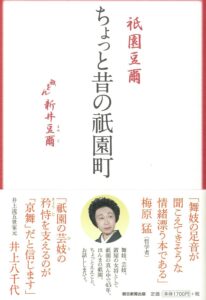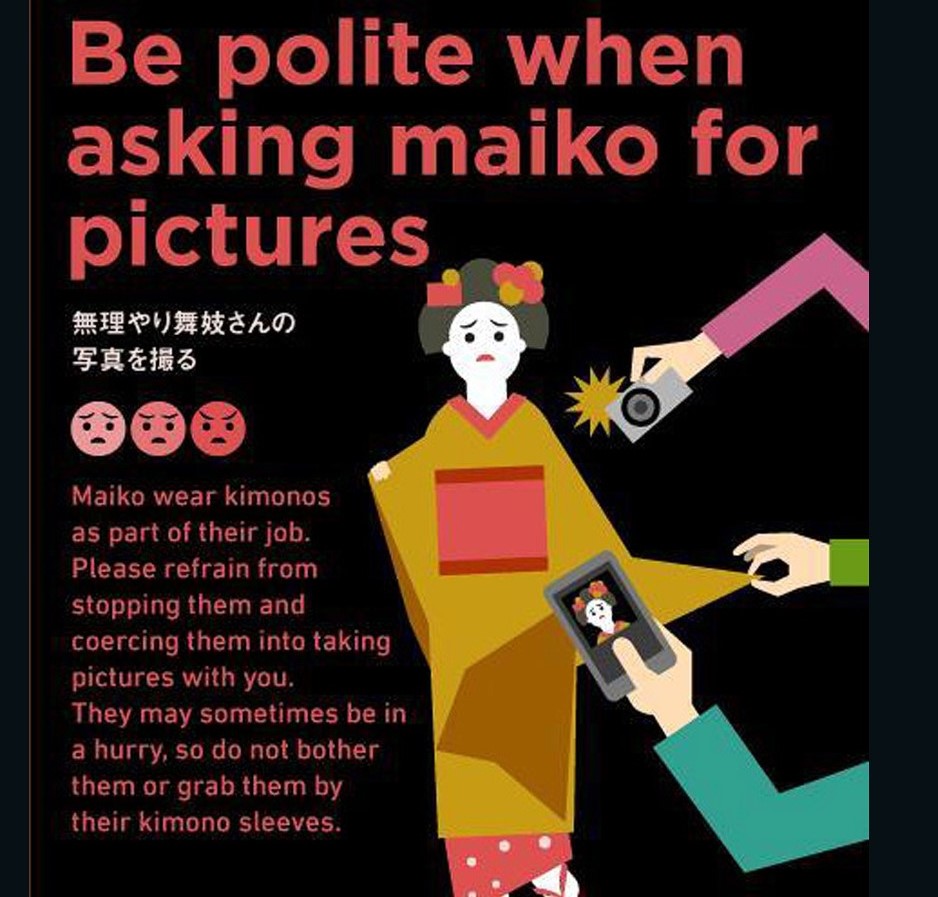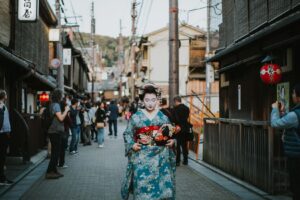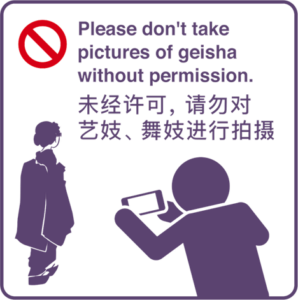How do maiko get treated to fancy dinners?
What maiko misadventures occur in stories of these events?
Today’s post explains the custom of clients taking maiko out to dinner, gohan tabe. We see the custom described in a TV drama, memoir, and a girls comic.
Dining out with the dashing talent scout
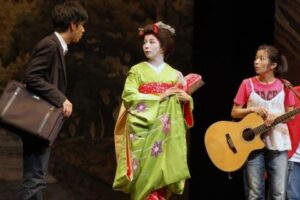
Talent manager talks with maiko Yumehana and her twin Megumi. in a scene from NHK-TV drama Dandan, 2008-09.
How exciting to be on a “date” with the young dashing talent scout Ishibashi-san! Usually only her twin Megumi, a college student, gets to do fun stuff. Dressed in her formal finery, maiko Yumehana basks in Ishibashi’s attention.
Little does she know this elegant dinner is prelude to calamity. For now, she enjoys the delight of the gohan tabe custom–when generous, long-time clients treat a maiko to dinner at a fine restaurant.
But before we discover the path to Yumehana’s misadventure, let’s explore the changing conventions of gohan tabe.
Dinner to the rescue of the busy maiko
Having only two days off per month, maiko follow a busy schedule of daytime arts lessons and evening parties. To give the maiko a break, and with the permission of her okiya mother, a client will invite her for a meal at a fine restaurant. The client pays for the maiko’s time from the point that she leaves her okiya to the time she returns. He covers all costs of the meal and taxis. For maiko, gohan tabe events are a welcome rescue from the strict supervision of their seniors–older maiko, geiko, and teahouse managers.
Watch your table manners
In her memoir, Arai Mameji, who became a maiko in 1969, recalls gohan tabe experiences. In the 1970s, okiya mothers accompanied maiko on these dinners. They insisted on chaperoning a maiko on any client outing. Arai also remembers being told to take care to follow proper table manners. Today, however, clients may take maiko to dinner without a chaperone.
As more women become teahouse clients, I wonder whether they, too, will participate in gohan tabe. So far, I have seen no evidence of that.
Maiko Taste: Macaroni over Posh Cuisine
On gohan tabe outings, maiko taste an elite world of luxury dining. But many report feeling out of their depth. French menus, elaborate table settings, and hushed environments are all new. Fictional maiko are befuddled, too.
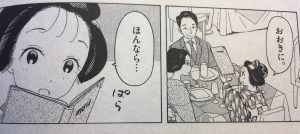
Maiko Momohana dines out with client and okiya mother. Koyama Aiko. Maiko-san-chi no Makanai-san, Vol. 4, Episode 40. page 116. (2017).
After paying for an exorbitantly priced meal, clients may be surprised to learn that maiko much prefer macaroni. This scene from Koyama Aiko’s maiko cooking manga shows Momohana on a gohan tabe outing. Having no idea how to read the menu, she orders what her mother does. Later, she tells other maiko that she has no idea what she ate. Back home at the okiya, she happily tucks into macaroni gratin.
Maiko Yumehana’s Gohan tabe Mishap
Returning to maiko Yumehana’s dinner with Ishibashi, we notice an unusual situation. Most teahouse clients are much older men, but Ishibashi is only in his twenties. This transforms gohan tabe into a cool date.
Calamity ensues when Ishibashi coaxes Yumehana to accompany him next to a “live house,” a young people’s hang out with live music. A talent scout, Ishibashi wants Yumehana to become a professional pop singer. Soon we see maiko Yumehana singing a pop song with Megumi at the live house. Big mistake!
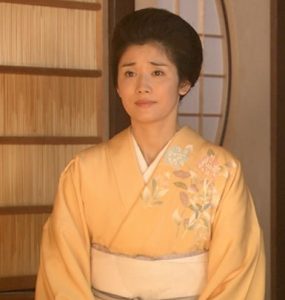
Actress Ishida Hikari as geiko Hanayuki.https://www2.nhk.or.jp/archives/jinbutsu/detail.cgidas_id=D0009070162_00000
Suddenly, Yumehana’s geisha mother Hanayuki appears! She catches Yumehana in the act of disrespecting her maiko uniform. Ever the poised professional, Hanayuki gently scolds Ishibashi. She thanks him for inviting Yumehana to gohan tabe, but reminds him of the custom’s boundaries. At teahouse parties, he may request any maiko dance in Yumehana’s repertoire. However, he must never ask her to go beyond the bounds of the maiko’s traditional arts. She cannot sing pop songs and certainly not dressed as a maiko. Yumehana must hurry to her next engagement, unsettled by her love of pop singing (and affection for Ishibashi).
For Hanayuki, this is definitely a case of gohan tabe gone wrong.
Jan Bardsley, “Treat a Maiko to Dinner (Hint: Mac and Cheese, Please).” janbardsley.web.unc.edu. March 25, 2021
I designed this website and blog for educational and informational purposes only. I strive to locate the names of the creators of texts and images cited, and properly acknowledge them.


